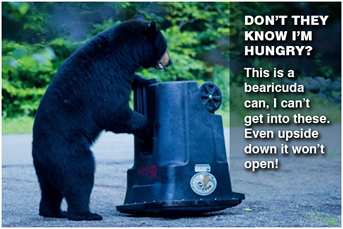Human/Bear Encounters Decrease in 2020
Bears were able to find food, such as berries in their natural habitat while bearproof cans deterred bears from seeking food in populated areas.
Bearproof Trash Containers Help Natural Food Availability For Bears
With the COVID-19 pandemic dominating the news in 2020, one issue that usually takes the spotlight in Colorado went unusually quiet... bear season.
It appears throughout the region, there just weren’t many human-bear conflicts like there have been during the past few years.
For the past few years, human-bear conflicts have been on the rise. Reports would come in on an almost daily basis of bears getting into trash, ripping down bird feeders or breaking into garages.
“Overall, it was a good year,” said Adrian Archuleta, Colorado Parks and Wildlife’s acting area wildlife manager in Durango.
In recent years, unfortunately, bears that became habitual offenders, lured by residents not securing food sources, would have to be euthanized on a semi-regular basis.
In 2017, for instance, a year with a bad natural food cycle and significant human-bear conflicts, a total of 36 bears were euthanized. This year, however, only nine bears were killed, and of those, only two or three were put down because of conflicts.(The other bears were put down for having injuries.)


The consensus among wildlife officials is that a strong natural food crop this year kept bears feasting in forests on foods they’re supposed to be eating. By July, reports of bear conflicts nearly ceased, Archuleta said.
Last year, CPW received around 300 calls to report bears for things like getting into trash or attempting to enter chicken coops. This year, CPW logged just 180 or so calls, a 40% reduction.
“It comes down to natural food availability,” Archuleta said.
Bryan Peterson with Bear Smart Durango said the region, in a prolonged drought, received just enough moisture to kick off a strong acorn crop this year, one of bears’ most important food sources.
“It just shows the power of an acorn crop,” he said. “That was the saving grace.”
Throughout the county, Peterson said Bear Smart received just 150 reports this year for things like bears getting into trash, going after fruit trees or trying to enter chicken coops, compared to 420 in 2017.
Human-bear conflicts were much the same in Durango with just 15 bear-related calls this year, compared to more than 200 calls in prior years.
Part of that success is attributed to available natural foods, but another factor is the widespread distribution of bear-resistant cans to households over the past few years.
In Bayfield, recently distributed cans to its residents are having a similar impact alleviating human-bear conflicts.
For the first time this year, CPW also used a different tactic in Durango that may have helped reduce human-bear conflicts. Rather than waiting to relocate a bear for a second offense, wildlife officials trapped and relocated bears after their first run-in, in an attempt to get the bear out of that situation before it developed a bad habit.
Peterson said it remains important to keep up educational efforts, especially as new residents move into the region. And with the lack of emphasis on securing trash, the nonprofit focused on other important issues, like gleaning fruit trees.
Bear Smart also helped more than 30 people install electric fences, mostly to secure chicken coops.
“The habitat is not in great condition because of drought conditions, and that’s something definitely of concern." Hopefully, an significant increase moisture will help product more natural food sources for bears away from residentail areas.
Original article from the Durango Herald:
Human-bear conflicts decreased in 2020

